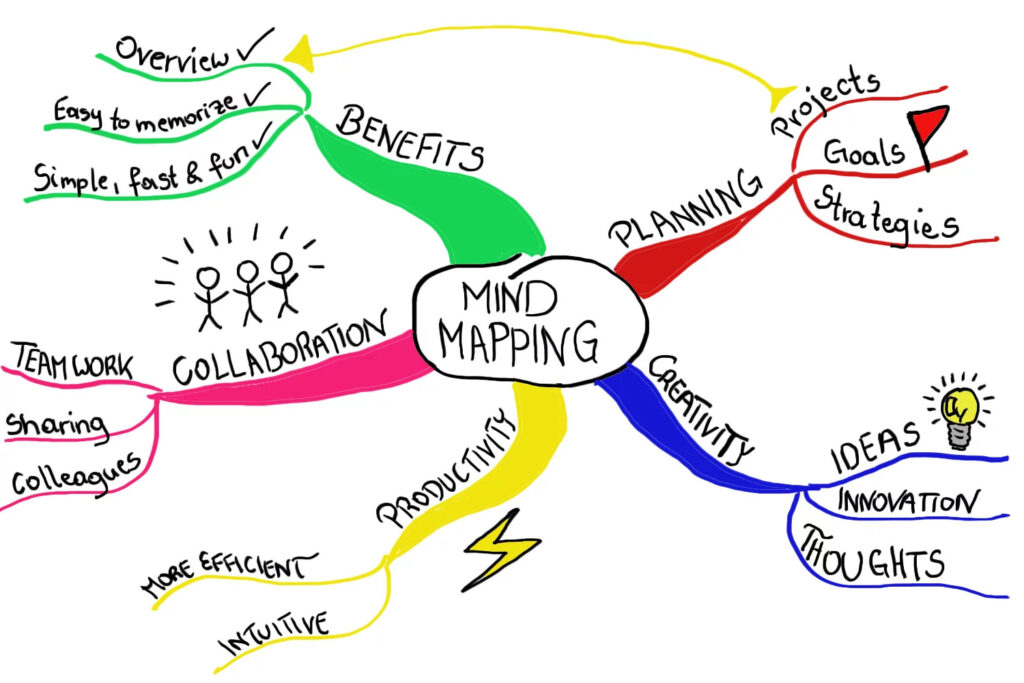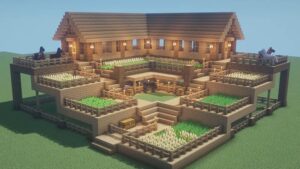Creative mind map ideas for students

Mind mapping is a visual way of organizing information and ideas, allowing individuals to create connections between different concepts and see the bigger picture. It can be a helpful tool for students to brainstorm ideas, plan projects, and study for exams. In this context, mind mapping can help students organize their thoughts, improve their memory retention, and enhance their creativity. This article will provide some mind map ideas for students, including topics such as time management, study skills, exam preparation, career exploration, and goal setting. By using mind-mapping techniques, students can improve their learning outcomes and achieve their academic goals.
The best topic for a mind map
The best topic for a mind map will depend on your interests, goals, and needs. Here are some ideas to consider mind map ideas for students:
- Personal development:
Create a mind map of personal goals, including areas for improvement and steps to achieve them.
- Creativity:
Create a mind map of creative ideas, including new ways to approach projects or solve problems.
- Career planning:
Create a mind map of potential career paths, including job titles, skills, and employers.
- Travel planning:
Create a mind map of potential travel destinations, including places to visit, transportation options, and accommodations.
- Project management:
Create a mind map of project goals, including milestones, resources, and deadlines.
- Language learning:
Create a mind map of vocabulary, grammar rules, and language practice activities to improve your language skills.
- Mindfulness:
Create a mind map of mindfulness exercises and techniques, including meditation, deep breathing, and mindfulness practices for stress reduction and relaxation.
- Science concepts:
Create a mind map of science concepts, including definitions, examples, and applications.
- Historical events:
Create a mind map of historical events, including key dates, figures, and outcomes.
- Health and wellness:
Create a mind map of health and wellness goals, including exercise routines, meal plans, and self-care strategies.
Importance things in the mind map
When creating a mind map, there are several important things that you should keep in mind to ensure that it is effective and useful. Here are some key elements to include in your mind map:
- Central idea:
This should be the main topic or concept that your mind map revolves around. It should be clear and concise, allowing you to easily build upon it and create branches for related ideas.
- Branches:
These are the sub-topics or related ideas that branch off of the central idea. Each branch should be labeled with a keyword or phrase that represents the idea it represents.
- Keywords and images:
To help you remember and recall the information in your mind map, use keywords and images that represent the ideas you’re trying to convey. This can be helpful in triggering your memory and making it easier to recall the information later.
- Color coding:
Using different colors can help you visually separate different sections of your mind map and create a hierarchy of information. You might use one color for the central idea, another color for main branches, and a third color for sub-branches.
- Connections:
Use lines or arrows to connect related ideas and show how they are connected to each other. This can help you see the bigger picture and how different ideas are related.
- Organization:
Mind maps should be organized in a way that makes sense to you. You might organize them chronologically, by topic, or by importance.
Mind map ideas for students’ creative
Sure, here are some ideas for a mind map for students to boost their creativity:
- Brainstorming Techniques:
This section can include different techniques for brainstorming such as Mind Mapping, SCAMPER, Random Word, and SWOT analysis.
- Creative Thinking Skills:
This section can include a list of skills that promote creative thinking such as imagination, curiosity, flexibility, open-mindedness, and problem-solving.
- Creative Activities:
This section can include a list of different creative activities such as painting, drawing, writing, storytelling, singing, and dancing.
- Inspirational People:
This section can include a list of inspirational people such as artists, writers, musicians, and scientists, who have used their creativity to make a difference in the world.
- Creative Projects:
This section can include a list of different creative projects such as designing a new product, creating a piece of art, writing a novel or a screenplay, or starting a business.
- Tools and Resources:
This section can include a list of tools and resources that can help students boost their creativity such as books, websites, software, and apps.
- Creativity Habits:
This section can include a list of habits that can help students develop their creativity such as setting aside time for creative pursuits, taking breaks, getting enough sleep, and engaging in physical activity.
- Overcoming Creative Blocks:
This section can include tips and strategies for overcoming creative blocks such as taking a different perspective, collaborating with others, or stepping away from the project for a while.
Mind map for students
Here are some ideas for creating a mind map for students:
- Study skills:
Create a mind map of different study skills that can help you learn more effectively. Include tips for note-taking, time management, and memory techniques.
- Academic goals:
Use a mind map to visualize your academic goals for the semester or year. Include specific goals for each subject, such as improving your grades or mastering a difficult topic.
- Creative writing:
Create a mind map for a creative writing project. Use the branches to map out different characters, settings, plot points, and themes.
- Historical events:
Create a mind map to visualize a historical event or period. Use branches to explore different aspects of the event, such as key players, causes, and consequences.
- Science concepts:
Create a mind map to visualize a science concept or theory. Use branches to explore different aspects of the concept, such as key terms, related theories, and real-world applications.
- Decision making:
Create a mind map to help you make a decision. Use branches to explore different options, pros and cons, and potential outcomes.
- Career exploration:
Create a mind map to explore different career options. Use branches to explore different fields, job titles, required skills, and potential salaries.
- Foreign language learning:
Create a mind map to help you learn a foreign language. Use branches to explore different aspects of the language, such as grammar rules, vocabulary, and sentence structure.
- Mindfulness:
Create a mind map to explore mindfulness techniques. Use branches to explore different practices, such as meditation, breathing exercises, and visualization.
- Health and wellness:
Create a mind map to explore different aspects of health and wellness. Use branches to explore different topics, such as nutrition, exercise, and mental health.
15 creative mind map examples for students
Here are 15 creative mind map examples for students:
- “My Goals” mind map:
Students can create a mind map of their goals for the school year or semester, including academic, personal, and extracurricular goals.
- “My Strengths and Weaknesses” mind map:
Students can create a mind map of their strengths and weaknesses, identifying areas where they excel and areas where they need to improve.
- “My Learning Style” mind map:
Students can create a mind map of their preferred learning style, including visual, auditory, and kinesthetic learning strategies.
- “My Study Habits” mind map:
Students can create a mind map of their study habits, including techniques for effective studying and time management.
- “My Dream Career” mind map:
Students can create a mind map of their dream career, including education requirements, job responsibilities, and potential earnings.
- “My Role Models” mind map:
Students can create a mind map of their role models, including personal qualities, achievements, and contributions to society.
- “My Favorite Book” mind map:
Students can create a mind map of their favorite book, including plot, characters, themes, and symbolism.
- “My Bucket List” mind map:
Students can create a mind map of their bucket list, including travel destinations, adventure activities, and personal milestones.
- “My Creative Process” mind map:
Students can create a mind map of their creative process, including brainstorming techniques, ideation, and implementation.
- “My Favorite Music Genre” mind map:
Students can create a mind map of their favorite music genre, including key characteristics, influential artists, and cultural significance.
- “My Daily Routine” mind map:
Students can create a mind map of their daily routine, including waking up, going to school, extracurricular activities, and relaxation time.
- My Family Tree” mind map:
Students can create a mind map of their family tree, including relatives, relationships, and genealogy.
- “My Hobbies and Interests” mind map:
Students can create a mind map of their hobbies and interests, including sports, crafts, music, and other activities.
- “My Favorite Food” mind map:
Students can create a mind map of their favorite food, including ingredients, preparation methods, and cultural significance.
- “My Future Plans” mind map:
Students can create a mind map of their future plans, including education, career, family, and personal goals.
Mind map topic ideas
Sure, here are some mind map topic ideas:
- Personal Development:
This topic can include self-improvement, goal setting, time management, and stress reduction.
- Business Planning:
This topic can include startup ideas, marketing strategies, financial planning, and competitive analysis.
- Education:
This topic can include learning strategies, study techniques, career planning, and academic research.
- Travel:
This topic can include destination ideas, itinerary planning, cultural exploration, and language learning.
- Health and Fitness:
This topic can include exercise routines, nutrition planning, meditation techniques, and mental health management.
- Creativity:
This topic can include brainstorming techniques, inspiration sources, creative thinking exercises, and artistic expression.
- Technology:
This topic can include new software and hardware, coding languages, cybersecurity, and digital marketing.
- Environment:
This topic can include climate change, conservation, sustainability, and eco-friendly practices.
- Science:
This topic can include physics, chemistry, biology, and astronomy, and scientific research and discovery.
- History:
This topic can include world history, art history, political history, and cultural history.
- Relationships:
This topic can include family relationships, romantic relationships, friendship, and communication.
- Food and Drink:
This topic can include cooking techniques, ingredients, cultural cuisine, and wine and spirits.
- Literature:
This topic can include classic literature, contemporary literature, poetry, and genre fiction.
- Art and Design:
This topic can include architecture, graphic design, fashion, and visual arts.
- Politics and Current Events:
This topic can include international politics, domestic policies, and social justice issues.
Advantages of mind map ideas for students
There are many advantages of using mind map ideas for students, including:
- Improved Learning:
Mind maps can help students retain information better by visualizing relationships and connections between concepts, which can enhance their understanding of the subject matter.
- Enhanced Creativity:
Mind maps can stimulate students’ creativity by encouraging them to think critically and creatively, and to come up with innovative ideas and solutions.
- Better Organization:
Mind maps can help students organize their thoughts and ideas in a structured and logical way, making it easier for them to study and revise.
- Increased Productivity:
Mind maps can help students manage their time more effectively by breaking down complex tasks into smaller, more manageable parts.
- Active Learning:
Mind maps encourage students to be more engaged in the learning process, as they are actively participating in creating their own visual representation of the topic.
- Collaboration:
Mind maps can be used as a tool for collaborative learning, allowing students to work together to create a shared understanding of the topic.
- Versatility:
Mind maps can be used for a variety of subjects and purposes, from brainstorming ideas to planning essays to summarizing lecture notes.
Faqs
Here are some frequently asked questions (FAQs) about mind map ideas for students:
Q.1 What is a mind map?
A mind map is a visual tool used to organize and represent information in a hierarchical and interconnected manner. It typically starts with a central idea or topic, with related subtopics and ideas branching out from it.
Q.2 How can mind maps help students learn?
Mind maps can help students learn by facilitating their understanding of complex concepts, improving their memory retention, and encouraging active participation in the learning process. They also help students organize information in a way that is easy to understand and retain.
Q.3 What are some tips for creating effective mind maps?
To create an effective mind map, start by choosing a central idea or topic and adding related subtopics and ideas. Use colors, symbols, and images to make the mind map visually engaging and memorable. Keep the mind map simple and easy to read by using short phrases and keywords instead of lengthy sentences.
Q.4 What subjects are suitable for mind maps?
Mind maps can be used for a wide range of subjects, including science, math, literature, history, art, and more. They can be used to brainstorm ideas, plan essays, summarize lecture notes, and study for exams.
Q.5 Are there any tools or software for creating mind maps?
Yes, there are many tools and software available for creating mind maps, such as MindMeister, XMind, and Coggle. Many of these tools offer free or trial versions that students can use to create their own mind maps.
Final thoughts
In conclusion, using mind map ideas can be a useful tool for students to improve their learning and study skills. Mind maps can help students visualize complex concepts, organize information, and retain knowledge more effectively. They can also encourage creativity, critical thinking, and active participation in the learning process. There are many tools and software available for creating mind maps, making it easy and accessible for students to incorporate this technique into their study habits. Whether for brainstorming ideas, planning essays, or summarizing lecture notes, mind maps are a versatile and effective tool for students of all ages and subjects.
Mind mapping is a visual way of organizing information and ideas, allowing individuals to create connections between different concepts and see the bigger picture. It can be a helpful tool for students to brainstorm ideas, plan projects, and study for exams. In this context, mind mapping can help students organize their thoughts, improve their memory retention, and enhance their creativity. This article will provide some mind map ideas for students, including topics such as time management, study skills, exam preparation, career exploration, and goal setting. By using mind-mapping techniques, students can improve their learning outcomes and achieve their academic goals.
The best topic for a mind map
The best topic for a mind map will depend on your interests, goals, and needs. Here are some ideas to consider mind map ideas for students:
- Personal development:
Create a mind map of personal goals, including areas for improvement and steps to achieve them.
- Creativity:
Create a mind map of creative ideas, including new ways to approach projects or solve problems.
- Career planning:
Create a mind map of potential career paths, including job titles, skills, and employers.
- Travel planning:
Create a mind map of potential travel destinations, including places to visit, transportation options, and accommodations.
- Project management:
Create a mind map of project goals, including milestones, resources, and deadlines.
- Language learning:
Create a mind map of vocabulary, grammar rules, and language practice activities to improve your language skills.
- Mindfulness:
Create a mind map of mindfulness exercises and techniques, including meditation, deep breathing, and mindfulness practices for stress reduction and relaxation.
- Science concepts:
Create a mind map of science concepts, including definitions, examples, and applications.
- Historical events:
Create a mind map of historical events, including key dates, figures, and outcomes.
- Health and wellness:
Create a mind map of health and wellness goals, including exercise routines, meal plans, and self-care strategies.
Importance things in the mind map
When creating a mind map, there are several important things that you should keep in mind to ensure that it is effective and useful. Here are some key elements to include in your mind map:
- Central idea:
This should be the main topic or concept that your mind map revolves around. It should be clear and concise, allowing you to easily build upon it and create branches for related ideas.
- Branches:
These are the sub-topics or related ideas that branch off of the central idea. Each branch should be labeled with a keyword or phrase that represents the idea it represents.
- Keywords and images:
To help you remember and recall the information in your mind map, use keywords and images that represent the ideas you’re trying to convey. This can be helpful in triggering your memory and making it easier to recall the information later.
- Color coding:
Using different colors can help you visually separate different sections of your mind map and create a hierarchy of information. You might use one color for the central idea, another color for main branches, and a third color for sub-branches.
- Connections:
Use lines or arrows to connect related ideas and show how they are connected to each other. This can help you see the bigger picture and how different ideas are related.
- Organization:
Mind maps should be organized in a way that makes sense to you. You might organize them chronologically, by topic, or by importance.
Mind map ideas for students’ creative
Sure, here are some ideas for a mind map for students to boost their creativity:
- Brainstorming Techniques:
This section can include different techniques for brainstorming such as Mind Mapping, SCAMPER, Random Word, and SWOT analysis.
- Creative Thinking Skills:
This section can include a list of skills that promote creative thinking such as imagination, curiosity, flexibility, open-mindedness, and problem-solving.
- Creative Activities:
This section can include a list of different creative activities such as painting, drawing, writing, storytelling, singing, and dancing.
- Inspirational People:
This section can include a list of inspirational people such as artists, writers, musicians, and scientists, who have used their creativity to make a difference in the world.
- Creative Projects:
This section can include a list of different creative projects such as designing a new product, creating a piece of art, writing a novel or a screenplay, or starting a business.
- Tools and Resources:
This section can include a list of tools and resources that can help students boost their creativity such as books, websites, software, and apps.
- Creativity Habits:
This section can include a list of habits that can help students develop their creativity such as setting aside time for creative pursuits, taking breaks, getting enough sleep, and engaging in physical activity.
- Overcoming Creative Blocks:
This section can include tips and strategies for overcoming creative blocks such as taking a different perspective, collaborating with others, or stepping away from the project for a while.
Mind map for students
Here are some ideas for creating a mind map for students:
- Study skills:
Create a mind map of different study skills that can help you learn more effectively. Include tips for note-taking, time management, and memory techniques.
- Academic goals:
Use a mind map to visualize your academic goals for the semester or year. Include specific goals for each subject, such as improving your grades or mastering a difficult topic.
- Creative writing:
Create a mind map for a creative writing project. Use the branches to map out different characters, settings, plot points, and themes.
- Historical events:
Create a mind map to visualize a historical event or period. Use branches to explore different aspects of the event, such as key players, causes, and consequences.
- Science concepts:
Create a mind map to visualize a science concept or theory. Use branches to explore different aspects of the concept, such as key terms, related theories, and real-world applications.
- Decision making:
Create a mind map to help you make a decision. Use branches to explore different options, pros and cons, and potential outcomes.
- Career exploration:
Create a mind map to explore different career options. Use branches to explore different fields, job titles, required skills, and potential salaries.
- Foreign language learning:
Create a mind map to help you learn a foreign language. Use branches to explore different aspects of the language, such as grammar rules, vocabulary, and sentence structure.
- Mindfulness:
Create a mind map to explore mindfulness techniques. Use branches to explore different practices, such as meditation, breathing exercises, and visualization.
- Health and wellness:
Create a mind map to explore different aspects of health and wellness. Use branches to explore different topics, such as nutrition, exercise, and mental health.
15 creative mind map examples for students
Here are 15 creative mind map examples for students:
- “My Goals” mind map:
Students can create a mind map of their goals for the school year or semester, including academic, personal, and extracurricular goals.
- “My Strengths and Weaknesses” mind map:
Students can create a mind map of their strengths and weaknesses, identifying areas where they excel and areas where they need to improve.
- “My Learning Style” mind map:
Students can create a mind map of their preferred learning style, including visual, auditory, and kinesthetic learning strategies.
- “My Study Habits” mind map:
Students can create a mind map of their study habits, including techniques for effective studying and time management.
- “My Dream Career” mind map:
Students can create a mind map of their dream career, including education requirements, job responsibilities, and potential earnings.
- “My Role Models” mind map:
Students can create a mind map of their role models, including personal qualities, achievements, and contributions to society.
- “My Favorite Book” mind map:
Students can create a mind map of their favorite book, including plot, characters, themes, and symbolism.
- “My Bucket List” mind map:
Students can create a mind map of their bucket list, including travel destinations, adventure activities, and personal milestones.
- “My Creative Process” mind map:
Students can create a mind map of their creative process, including brainstorming techniques, ideation, and implementation.
- “My Favorite Music Genre” mind map:
Students can create a mind map of their favorite music genre, including key characteristics, influential artists, and cultural significance.
- “My Daily Routine” mind map:
Students can create a mind map of their daily routine, including waking up, going to school, extracurricular activities, and relaxation time.
- My Family Tree” mind map:
Students can create a mind map of their family tree, including relatives, relationships, and genealogy.
- “My Hobbies and Interests” mind map:
Students can create a mind map of their hobbies and interests, including sports, crafts, music, and other activities.
- “My Favorite Food” mind map:
Students can create a mind map of their favorite food, including ingredients, preparation methods, and cultural significance.
- “My Future Plans” mind map:
Students can create a mind map of their future plans, including education, career, family, and personal goals.
Mind map topic ideas
Sure, here are some mind map topic ideas:
- Personal Development:
This topic can include self-improvement, goal setting, time management, and stress reduction.
- Business Planning:
This topic can include startup ideas, marketing strategies, financial planning, and competitive analysis.
- Education:
This topic can include learning strategies, study techniques, career planning, and academic research.
- Travel:
This topic can include destination ideas, itinerary planning, cultural exploration, and language learning.
- Health and Fitness:
This topic can include exercise routines, nutrition planning, meditation techniques, and mental health management.
- Creativity:
This topic can include brainstorming techniques, inspiration sources, creative thinking exercises, and artistic expression.
- Technology:
This topic can include new software and hardware, coding languages, cybersecurity, and digital marketing.
- Environment:
This topic can include climate change, conservation, sustainability, and eco-friendly practices.
- Science:
This topic can include physics, chemistry, biology, and astronomy, and scientific research and discovery.
- History:
This topic can include world history, art history, political history, and cultural history.
- Relationships:
This topic can include family relationships, romantic relationships, friendship, and communication.
- Food and Drink:
This topic can include cooking techniques, ingredients, cultural cuisine, and wine and spirits.
- Literature:
This topic can include classic literature, contemporary literature, poetry, and genre fiction.
- Art and Design:
This topic can include architecture, graphic design, fashion, and visual arts.
- Politics and Current Events:
This topic can include international politics, domestic policies, and social justice issues.
Advantages of mind map ideas for students
There are many advantages of using mind map ideas for students, including:
- Improved Learning:
Mind maps can help students retain information better by visualizing relationships and connections between concepts, which can enhance their understanding of the subject matter.
- Enhanced Creativity:
Mind maps can stimulate students’ creativity by encouraging them to think critically and creatively, and to come up with innovative ideas and solutions.
- Better Organization:
Mind maps can help students organize their thoughts and ideas in a structured and logical way, making it easier for them to study and revise.
- Increased Productivity:
Mind maps can help students manage their time more effectively by breaking down complex tasks into smaller, more manageable parts.
- Active Learning:
Mind maps encourage students to be more engaged in the learning process, as they are actively participating in creating their own visual representation of the topic.
- Collaboration:
Mind maps can be used as a tool for collaborative learning, allowing students to work together to create a shared understanding of the topic.
- Versatility:
Mind maps can be used for a variety of subjects and purposes, from brainstorming ideas to planning essays to summarizing lecture notes.
Faqs
Here are some frequently asked questions (FAQs) about mind map ideas for students:
Q.1 What is a mind map?
A mind map is a visual tool used to organize and represent information in a hierarchical and interconnected manner. It typically starts with a central idea or topic, with related subtopics and ideas branching out from it.
Q.2 How can mind maps help students learn?
Mind maps can help students learn by facilitating their understanding of complex concepts, improving their memory retention, and encouraging active participation in the learning process. They also help students organize information in a way that is easy to understand and retain.
Q.3 What are some tips for creating effective mind maps?
To create an effective mind map, start by choosing a central idea or topic and adding related subtopics and ideas. Use colors, symbols, and images to make the mind map visually engaging and memorable. Keep the mind map simple and easy to read by using short phrases and keywords instead of lengthy sentences.
Q.4 What subjects are suitable for mind maps?
Mind maps can be used for a wide range of subjects, including science, math, literature, history, art, and more. They can be used to brainstorm ideas, plan essays, summarize lecture notes, and study for exams.
Q.5 Are there any tools or software for creating mind maps?
Yes, there are many tools and software available for creating mind maps, such as MindMeister, XMind, and Coggle. Many of these tools offer free or trial versions that students can use to create their own mind maps.
Final thoughts
In conclusion, using mind map ideas can be a useful tool for students to improve their learning and study skills. Mind maps can help students visualize complex concepts, organize information, and retain knowledge more effectively. They can also encourage creativity, critical thinking, and active participation in the learning process. There are many tools and software available for creating mind maps, making it easy and accessible for students to incorporate this technique into their study habits. Whether for brainstorming ideas, planning essays, or summarizing lecture notes, mind maps are a versatile and effective tool for students of all ages and subjects.






